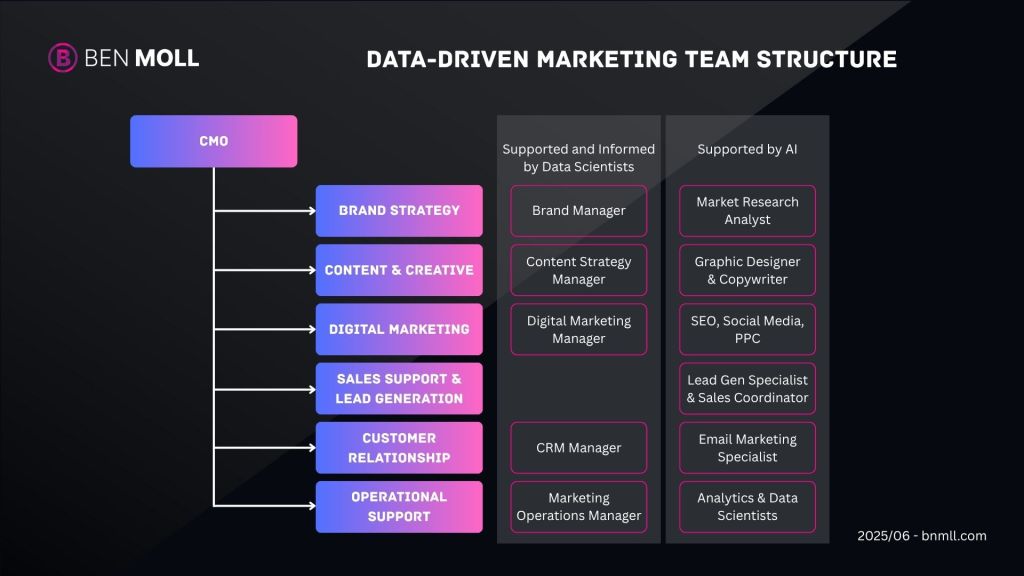In today’s hypercompetitive digital landscape, the power of data can no longer be underestimated. For businesses aiming to stay ahead, building a data-driven marketing team is no longer a luxury but a necessity. This team’s ability to harness analytics, customer insights, and AI-driven tools drives smarter decisions and maximizes marketing ROI. If you’re a marketing leader ready to transform your department, understanding the blueprint to build a proficient data-driven marketing team is essential.
In this article, we’ll explore the key components of assembling a high-performing team, the skills that matter, technology stacks, and the organizational culture needed to embed data-driven decision-making. You’ll also discover practical strategies for recruitment, training, and collaboration to future-proof your marketing efforts.

Why Every Marketing Leader Needs a Data-Driven Marketing Team
Marketing is evolving rapidly. Traditional creative intuition remains important, but it must be complemented with data insights for campaigns to perform in real time. A data-driven marketing team uses analytics, customer behavior data, and test results to optimize strategies, budget allocations, and channel activation. This approach leads to:
- Higher ROI and reduced waste in spend
- Personalized customer experiences at scale
- Faster responsiveness to market trends and competitor moves
- Enhanced alignment between marketing and broader business goals
According to Gartner, 92% of leading marketers say data analytics is critical to their marketing strategy execution (source). As such, the ability to build and lead a data-driven marketing team is a skill all senior marketers must master.
Key Roles in a Data-Driven Marketing Team
Building a data-driven marketing team begins with identifying essential roles that cover data collection, analysis, creative execution, and strategy. The core team typically includes:
- Marketing Data Analyst: Translates raw data into actionable insights through dashboards and reports.
- Data Engineer: Ensures proper data infrastructure, quality, and integration between platforms.
- Growth Marketer: Applies insights to design and optimize campaigns based on continuous experimentation.
- CRM Specialist: Manages customer data and segmentation for personalized communications.
- Marketing Technologist: Oversees technology stack selection and implementation, including AI-driven tools.
- Content Strategist: Uses data to inform content themes and formats that resonate with target audiences.
Some organizations also include specialists in AI and predictive analytics as these technologies mature. Small teams might combine several roles, but clarity around responsibilities is crucial.
Skills & Competencies Essential for Your Data-Driven Marketing Team
A skilled team member in a data-driven marketing team blends analytical prowess with marketing savvy. Core competencies include:
- Data literacy: Fluency in data handling, statistical analysis, and visualization tools such as Tableau, Looker, or Power BI.
- Technical skills: Proficiency in SQL, Python, or R is often required for deeper data manipulation and modeling.
- Marketing acumen: Understanding of customer journeys, segmentation, and digital channels (SEO, PPC, email).
- Experimentation mindset: Aptitude for A/B testing, multivariate tests, and iterating campaigns.
- Cross-functional collaboration: Ability to work seamlessly with sales, product, and IT teams.
- Communication skills: Clear presentation of data insights to both technical and non-technical stakeholders.
Continuous learning is imperative. Encourage your team to pursue certifications in areas like Google Analytics, HubSpot, or AI applications. Data-driven marketing thrives on curiosity and adaptation.
Steps to Build Your Data-Driven Marketing Team NOW
1. Define Clear Objectives and Metrics
Before hiring, identify what “data-driven” means for your organization and what outcomes matter most. Focus on KPIs aligned with business goals such as customer acquisition cost (CAC), customer lifetime value (CLV), or conversion rates.
2. Assemble a Balanced Team
Use the roles outlined earlier as a blueprint, ensuring a balance of technical skills, marketing knowledge, and creativity. Evaluate existing talent and fill gaps strategically.
3. Invest in the Right Technology Stack
Equip your team with analytics platforms, data warehouses, and automation tools. Modern marketing requires integration between CRM systems, web analytics, and AI-powered personalization tools. Platforms like Adobe Experience Cloud, Salesforce Marketing Cloud, and Google Marketing Platform are popular choices.
4. Foster a Collaborative, Data-Driven Culture
Data alone doesn’t drive results without an organizational mindset embracing transparency, experimentation, and data-based feedback loops. Encourage regular data-sharing meetings and joint problem-solving sessions.
5. Train and Develop Continuously
Provide ongoing training on the latest analytics tools, data privacy regulations, and marketing trends. Promote knowledge-sharing internally and through external courses or conferences.
6. Implement Agile Processes
Agile marketing methodologies enable your team to test, learn, and pivot quickly based on data. Adopt sprint cycles and real-time dashboards to keep everyone aligned.
7. Measure, Optimize, and Scale
Set up systems for continuous performance measurement. Use insights not only to optimize campaigns but also to refine team workflows. Scale successful strategies and tools across broader marketing functions.
Technology and Tools Powering a Data-Driven Marketing Team
The right tools enable your team to collect, analyze, and activate marketing data efficiently. Essential technology categories include:
- Data Management Platforms (DMPs): Aggregate and segment customer data across channels.
- Customer Data Platforms (CDPs): Build comprehensive customer profiles in real time.
- Analytics and BI Tools: Google Analytics 4, Tableau, Power BI, and others for actionable insights.
- Marketing Automation: HubSpot, Marketo, Pardot streamline personalized campaigns.
- Attribution and Experimentation Tools: Optimizely, Google Optimize for measuring impact and running tests.
- AI and Machine Learning Platforms: Tools such as IBM Watson or Adobe Sensei to predict customer behavior and optimize content delivery.
Integration between systems is critical to avoid data silos. Invest in APIs and middleware to create a unified marketing ecosystem.
Overcoming Common Challenges in Building a Data-Driven Marketing Team
Transitioning to a data-driven approach comes with hurdles. Anticipate and address these challenges:
- Data quality issues: Clean and consistent data is the foundation; prioritize governance and validation.
- Resistance to change: Some team members may distrust or misunderstand analytics; promote education and show quick wins.
- Siloed departments: Break down barriers by encouraging cross-team projects and shared goals.
- Resource constraints: Start small with a pilot team, then scale as ROI becomes apparent.
- Keeping pace with technology: Continuously evaluate your stack and adapt to emerging trends like generative AI.
According to McKinsey, data-driven organizations are 23 times more likely to acquire customers, 6 times more likely to retain customers, and 19 times more likely to be profitable (source).
Creating a Culture of Data-Driven Decision-Making
Technology and skills are only part of the equation. The real key to success lies in embedding data-driven thinking throughout your marketing organization.
- Encourage curiosity and experimentation—reward teams for using data to challenge assumptions.
- Promote transparency by sharing campaign results and dashboards openly.
- Align incentives to business outcomes rather than vanity metrics.
- Provide leadership buy-in and model data-centric decision-making from the top.
- Foster continuous feedback loops between marketing and sales, product, and customer success teams.

Measuring the Success of Your Data-Driven Marketing Team
Tracking the right KPIs is vital to demonstrate the team’s impact and refine strategies over time. Consider these metrics:
- Campaign ROI and incremental revenue growth
- Customer acquisition cost (CAC) and customer lifetime value (CLV)
- Conversion rates across marketing funnels
- Data quality and accuracy improvements
- Speed of insight delivery from analysis to action
Conclusion: Summary & Next Steps
Building a data-driven marketing team requires a strategic blend of talent, technology, culture, and processes. The rewards are significant — improved marketing effectiveness, personalization, and business growth.
- Define clear metrics aligned with your business goals before assembling the team.
- Hire or develop a balanced mix of data analysts, marketers, technologists, and strategists.
- Invest in integrated technology platforms that facilitate seamless data flow and real-time insights.
- Foster a culture of experimentation, transparency, and continuous learning.
- Measure impact rigorously and scale successful practices across the organization.
Ready to transform your marketing team? Connect with our experts to learn how we can help you build a high-impact data-driven marketing team equipped for the future. Request a consultation today on mastering data-driven marketing.






